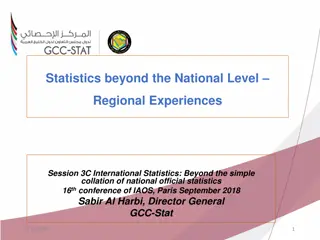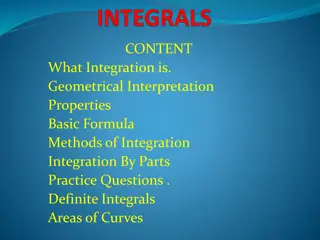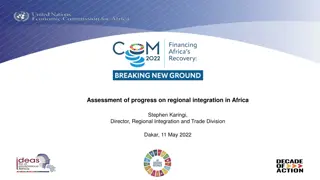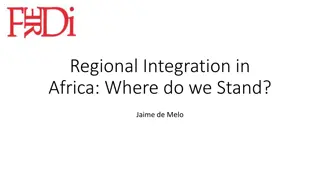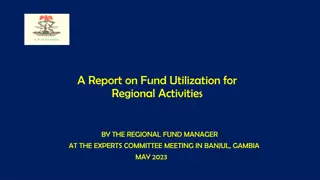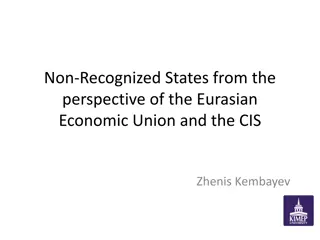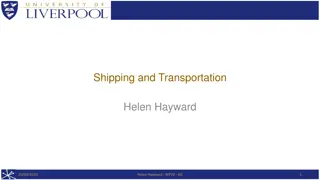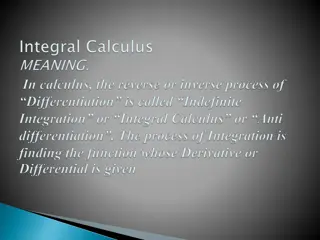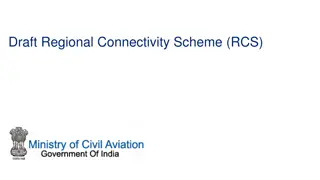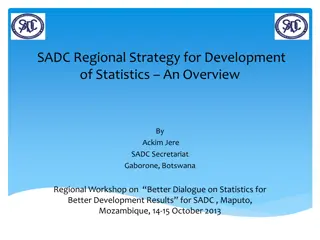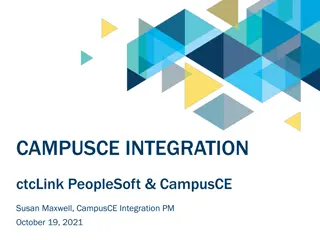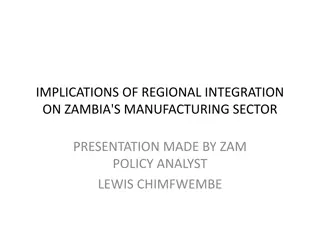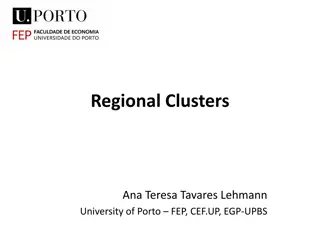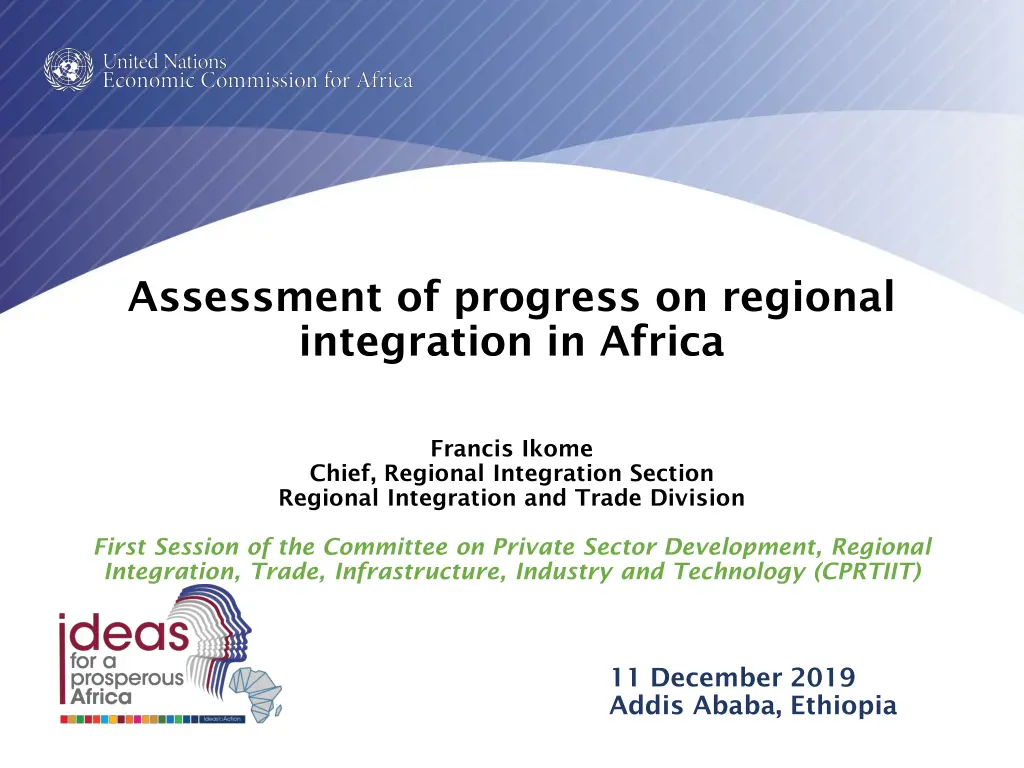
Assessment of Progress on Regional Integration in Africa: Focus and Recommendations
Explore the assessment of progress on regional integration in Africa, covering dimensions like trade, productive integration, macroeconomics, infrastructure, free movement of people, and governance. Recommendations for enhancing regional integration are also highlighted based on key indices and the Africa Regional Integration Index.
Download Presentation

Please find below an Image/Link to download the presentation.
The content on the website is provided AS IS for your information and personal use only. It may not be sold, licensed, or shared on other websites without obtaining consent from the author. If you encounter any issues during the download, it is possible that the publisher has removed the file from their server.
You are allowed to download the files provided on this website for personal or commercial use, subject to the condition that they are used lawfully. All files are the property of their respective owners.
The content on the website is provided AS IS for your information and personal use only. It may not be sold, licensed, or shared on other websites without obtaining consent from the author.
E N D
Presentation Transcript
Assessment of progress on regional integration in Africa Francis Ikome Chief, Regional Integration Section Regional Integration and Trade Division First Session of the Committee on Private Sector Development, Regional Integration, Trade, Infrastructure, Industry and Technology (CPRTIIT) 11 December 2019 Addis Ababa, Ethiopia
Outline Introduction & Background Progress in Regional Integration Dimensions: 1) Trade Integration 2) Productive Integration 3) Macroeconomic integration 4) Infrastructure Integration 5) Free Movement of People 6) Governance, Peace and Security Recommendations and Conclusions
Introduction and Background Regional integration is an economic and political priority for African countries. Although RECs have similar objectives, they continue to manifest differences in their structures and performances, including in the pace and level of achievement of their treaty goals and objectives. Factors that underpin this performance of RECs constitute useful lessons to be leveraged for the advancement of the region s integration agenda, including in the implementation of the AfCFTA. This presentation summarizes the assessment of progress on regional integration in Africa based on the Africa Regional Integration Index, and other key indices. Focuses on 5 dimensions of integration (Trade, Macroeconomic, productive integration, free mov t pple, and Governance P/S)
1. Trade Integration Intra-African trade gradually increased to 16.1 per cent of total African trade in 2018 (to reach $159.1 billion), up from 15.5% in 2017. This remains very low by regional comparisons, eg. Asia (52%) and Europe (73%). Africa s share of world exports at 2.3%, while share of world imports at 2.5% Main causes - lack of industrialization, manufacturing and value addition - most African countries have a commodity export dependence of over 80%. RECs making strides to boost trade in general and intra-regional trade in particular including through trade facilitation.
RECs Performance on Trade Integration On this Dimension, ARII focuses on average Average intra-regional import tariffs Share of intra-regional exports over GDP Share of intra-regional imports over GDP Share of intra-regional trade Whether REC member states have signed and ratified AfCFTA 0.8 0.7 0.6 0.5 0.4 0.3 Many RECs have low trade integration scores, with an average score of 0.383. 0.2 0.1 Highest performing RECs are AMU (0.481) and COMESA (0.445) 0 EAC AMU ECCAS IGAD ECOWAS CEN-SAD COMESA SADC Macroeconomic Integration Trade Integration Productive Integration SADC has the least score of 0.340. Infrastructure Integration Free Movement of People
ECA work in Supporting Trade Integration in RECs Significant portion of work dedicated to supporting trade integration. Successful conclusion of ACFTA negotiations 3Protocols. Development of tools to assess and monitor the implementation of the AfCFT. Assistance in a demand-driven programme Research and dissemination of policy findings. Analytical work in areas related to trade National development plans, that promote intra-African trade.
2. Productive Integration On this Dimension, ARII focuses on average Share of intra-regional intermediate exports Share of intra-regional intermediate imports Merchandise trade complementarity index (how intra-REC imports and export patterns complement each other) 0.8 0.7 0.6 0.5 0.4 Poorest performing Productive integration facilitate better integration of M/S into RVCs and GVCs 0.3 0.2 Majority of RECs (5 of them) have productive integration as their poorest-performing dimension of regional integration. 0.1 0 EAC AMU ECCAS IGAD ECOWAS CEN-SAD COMESA SADC AMU and EAC leading in Productive integration with 0.449 and 0.434 index scores respectively Macroeconomic Integration Trade Integration Productive Integration Infrastructure Integration Free Movement of People ECOWAS least with 0.220 score.
Boosting Productive Integration SADC implementing SADC industrialization strategy and road map (2015 2063) Developed Draft Protocol on Industry to promote competitive industrial bases in the region. Undertaken studies to establish priority RVCs agro-processing, minerals and pharmaceuticals industries to increase intraregional trade and integration EAC implementing EAC Industrialization Policy (2012-2032) COMESA Industrial Strategy (2017 2026) and also approved (in June 2019) COMESA Action Plan and Regional Guidelines on Local Content Policy to facilitate industrialization. ECOWAS West African Common Industrial Policy (WACIP, 2015-2020) Poorest-performing dimension of regional integration in majority of RECs. Most communities are lagging in terms of intraregional intermediate exports and imports. Very low levels of productive integration hamper effective regional integration There are several initiatives being carried out to improve the situation A draft protocol on industry has been developed to promote competitive industrial bases in the region EAC is implementing its East African Community Industrialization Policy (2012 2032) ECA has supported the EAC secretariat and member States in the development of the EAC Energy Security Policy Framework (COMESA) has developed the COMESA industrial strategy (2017 2026) o o o o
3. Macro-Economic Integration On this Dimension, ARII focuses on average Number of bilateral investment treaties Regional convertibility of currency Regional inflation differential (differences M/S inflate rate and REC targeted inflation rate) 0.8 0.7 0.6 0.5 The 8 RECs have an average macroeconomic integration score of 0.399 0.4 ECCAS and EAC are the highest performing communities in macroeconomic integration, with 0.684 and 0.660 scores, respectively 0.3 0.2 0.1 Most RECs making strides towards macroeconomic and monetary convergence targets Progress by WAEMU & CEMAC M/S COMESA s regional payment & settlement system The Pan-African Payment and Settlement System (PAPSS) launched by the Afreximbank in July 2019 0 EAC AMU ECCAS IGAD ECOWAS CEN-SAD COMESA SADC Macroeconomic Integration Trade Integration Productive Integration Infrastructure Integration Free Movement of People
3. Infrastructure Integration Infrastructure is an enabler of physical integration, production, trade facilitation and economic linkages RECs are implementing transboundary infrastructure initiatives and programmes with a focus on multi-modal infrastructure projects. Road Transport - projects in Africa that are now at advanced stages of preparation or ready for funding and implementation under PIDA eg. Abidjan-Lagos Coastal Corridor Project ($290 million); North-South Multimodal Corridor Project ($2,325 million); Central Corridor Project ($840 million); and the Trans-Maghreb Highway Project ($75 million). Rail Transport - many M/S engaged in cross-border railway projects (eg. SGR in EAC), which will complement Africa s Integrated High Speed Railway Network Project. More M/S joining the SAATM to remove restrictions in existing bilateral air service agreements 28 M/S have since joined Energy regional power interconnectors and cross-border energy projects (eg. Batoka Gorge between Zambia & Zimbabwe) boosting Power Pools ICT - transboundary Fibre-optic Link Project under construction in most RECs, eg. Freetown-Monrovia-Abidjan Fibre-optic Link Project, Bissau-Conakry and Conakry- Bamako Fibre-optic Link Projects in ECOWAS LLDCs benefiting to address their special needs and challenges via corridor projects
Performance of RECs in Infrastructure Integration On this Dimension, ARII focuses on average AfDB Composite Infrastructure index based the extent to which transport; electricity; ICT; water and sanitation directly or indirectly impact on productivity or economic growth. Proportion of intra-regional flight connections 0.8 0.7 0.6 0.5 The average score of Africa on infrastructure integration is a mere 0.220, with 31 out of the 54 countries classified as low performers while only 11 M/S are average performers 0.4 0.3 0.2 EAC and AMU have the most integrated infrastructure with 0.555 and 0.509 index scores respectively 0.1 ECOWAS and SADC have the least infrastructure integrated scores of 0.299 and 0.214 0 EAC AMU ECCAS IGAD ECOWAS CEN-SAD COMESA SADC At country level, South Africa (with 0.898 score) is on top, followed by Egypt, Seychelles and Morocco respectively. Macroeconomic Integration Trade Integration Productive Integration Infrastructure Integration Free Movement of People
4. Migration and Free Movement of People On this Dimension, ARII focuses on average whether or not a country has ratified the AU Protocol on the Free Movement of Persons number of regional countries whose citizens are granted visas on arrival 0.8 0.7 0.6 number of regional countries whose citizens strictly require visas when travelling to each country in the region 0.5 ECOWAS and EAC best performing RECs with 0.733 and 0.664 scores 0.4 COMESA has the weakest performance, with an average score of 0.385. 0.3 0.2 Progress made, the average African can now travel to 25% of other African countries without a visa (up from 22% in 2017 from 20% in 2016) 0.1 AU Protocol on the Free Movement of Persons on ratified by 4 countries as of July 2019 0 EAC AMU ECCAS IGAD ECOWAS CEN-SAD COMESA SADC ECA assisting RECs, eg. partnering ECOWAS to harmonize and align its regional framework on the free movement of people with the AU Protocol on Free Movement of Persons Macroeconomic Integration Trade Integration Productive Integration Infrastructure Integration Free Movement of People
5. Governance, Peace and Security Governance, peace and security challenges affect the implementation of regional integration programmes and projects. The Joint UN-AU Framework for Enhanced Partnership in Peace and Security (2017) facilitate collaboration on conflict prevention, peacekeeping, peace support operations, and security via joint mechanisms and regular consultations and close collaborations with RECs. In 2018 and 2019, peace and security challenges experienced in different countries and RECs such as IGAD, ECOWAS, IGAD, EAC; SADC, ECCAS. ECA continued to contribute towards securing peace, security and stability in the Sahel region via the UN Integrated Strategy for the Sahel (UN Sahel Support Plan, 2018 2022). In July 2018, the AU repositioned the African Peer Review Mechanism (APRM) as a tool for conflict prevention ECA has provided advisory services and capacity-building programmes, and has developed knowledge products towards the strengthening of the APRM.
Recommendations To assist RECs to improve their performance on the Dimensions of regional integration; the Secretariat would want to continue to: 1. supporting RECs inmainstreaming BIAT in their programmes and polices. 2. strengthen its support of this goal, building on the collaborative work on regional industrialization as has already been initiated in SADC and ECOWAS 3. broaden its capacity-building programme on the use of macroeconomic and forecasting models in economic planning and development to empower member States and RECs. 4. Support AfCFTA ratification drive and implementation, including through AfCFTA awareness-raising programmes, developing national AfCFTA implementation strategies and more analytical studies. 5. Support efforts to expedite the ratification of the Protocol on the Free Movement of Persons 6. refine and strengthen assessment tools such as ARII, ACBI Index, ARIA and other analytical studies on RECs. 7. Encourage more African countries to join the Single African Air Transport Market to facilitate the full implementation of the Yamoussoukro Decision on Liberalization of Air Transport Markets in Africa 8. Assist African LLDCs in mainstreaming the VPoA into their development strategies, while RECs integrate these into their programmes of work.

